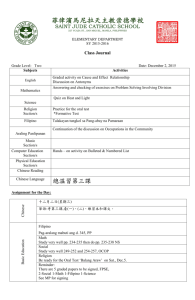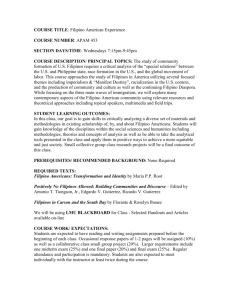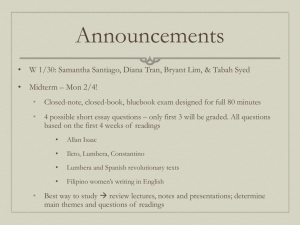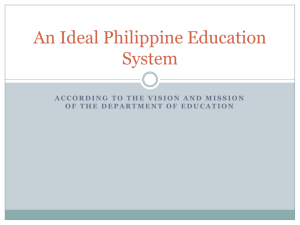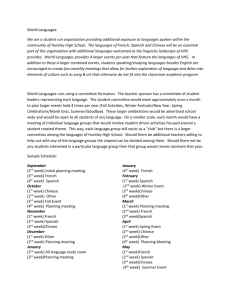The Ethno- Cultural and Historical Heritages: - PNU
advertisement
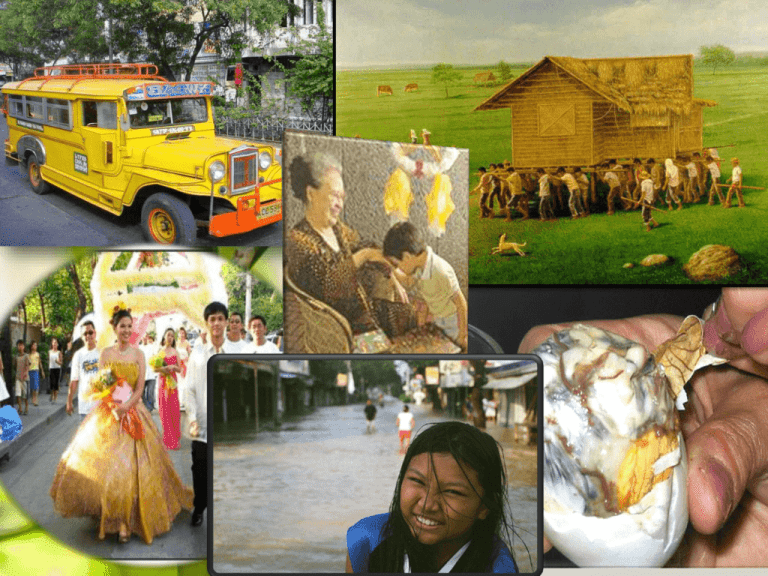
The Ethno- Cultural and Historical Heritages: The Peopling of the Philippines from Pre-Colonial to Post-War Period THE TABON MAN This refers to the fossilized human remains of a modern man, homo sapiens as distinguished from a midpleistocene homo erectus species found in the Tabon Cave of Palawan Philippines on May 28, 1962. Carbon 14 dated to roughly 22,000 – 20,000 BCE. This means the fossilized remains was premongoloid (pre modern Malay, Indonesian, pacific, Filipino) and does not resembles a Negrito. As recently as 1971, a band of 27 people who called themselves the Tasaday were brought to world attention because they appeared to have been a stone-age, foodgathering tribe living totally isolated in the rainforests of South Cotabato on Mindanao. The Metal Age: Bamboo People The Metal Age, which followed some 700 to 200 years B.C., further broadened cultural horizons. The ever-handy tool, the bolo (which has become part of the English language) emerged; and with this tool, bamboo was exploited efficiently. Si Malakas at Si Maganda • Filipinos have been described as a bamboo people. • Traces of the Metal Age lifestyle are still visible among various cultural minority groups, such as the T’boli of Mindanao and the Ifugao in the mountain Province. Both these groups still retain small-scale metal casting work. • In the Metal Age, pottery reached a high peak of development and evidence of the potter’s skill can be viewed in various national repositories and private collections. • Weaving flourished, a back-strap loom, tiedye textile art is still in practice among existing cultural minority groups. There was much interaction between tribal and regional groups. Archeological evidence reveals dissemination of pottery wares and designs throughout the archipelago. Age of Trade and Contacts Arabe Unang mangangalakal ipinakilala ang Koran – Banal na Aklat kalendrayo Arabesque Indian Traders Barong- Tagalog Sarong, Putong Pamahiin Pgsaboy ng bigas sa bagong kasal paglalagay ng belo at kordon sa ikakasal pagsabit ng kwintas na gawa sa bulaklak na isinasabit sa mga panauhin Salita: mahal, tala, asawa, mukha, hari, ina, ganda CHINESE Foreign traders made their way to the archipelago from the 10th to the 16th centuries in a period known as the Age of Trade and Contacts. The Chinese sailed in their junks bringing porcelain and silk in exchange for deer horn, and beeswax. The Chinese contributed many things: culinary techniques, of course, such as sautéed dishes, and a variety of rice cake and noodles; various cooking implements such as the work (kawa) reveal their Chinese origin in the names used for these. The corner retail store and vegetable gardening are Chinese. The Filipino family structure was reinforced by the more rigid authoritarian Chinese style, and traditional Filipino families still make clear distinctions between family members, including from the oldest child and on down the line to the youngest, with names that are Chinese. The eldest son is addressed as kuya by the other children, the elder sister as ate; their authority as well as responsibility over younger siblings is clearly defined. The oldest church in the country, San Agustin in Manila (16th century), still displays a choir loft and chairs carved by Chinese in Canton; Chinese stone lions guard its churchyard walls. Intsik Sari-sari Store Pinngan, plorera, payong salamin, telang seda, karayom barter pagsuot ng itim o puting damit pag namatayan Paggamit ng paputok bilang pagdiriwang ng Bagong Taon Family Ties Pagiging Matipid Sungka, Baraha, Saranggola Pulbura, bakya, tsinelas Paawa ng alahas Salita: Ssi, ate , kuya, lumpia, pansit Hapones Paggawa ng Armas Kagamitan sa pagsasaka Metalurhiya ( paghihiwalay ng metal sa mineral) Pagkukulti (paggawang iba’t-ibang produkto mula sa balat ng hayop) Advents of Islam The Arabs, at about the same time as the Chinese, had also come to trade. In the Southeast Asian region the founding of Malacca, followed by the conversion of its leader in 1414, spread the influence of Islam among the Malay peoples, reaching shores around the 14th century. Christian Filipinos invoked the protection of saints the favorite being Santiago Apostol, known to the Spaniards as Santiago Matamoras (killer of Moors’). Vast quantities of porcelain diggings in recent years attest to the extent of inter-island domestic trade and cultural exchange. Gold jewelry of this period reveals highly sophisticated craftsmanship unequalled in many parts of the world. Introduction of Islamic Faith Marriage into Datu Families Islamization Process Trade and Commerce Consolidation of barangays into Sultanato The Spanish Period TYPICAL PHILIPPINE TOWN SETTING • Municipio ( government house) • Plaza Concept • Church The Fine Arts • The priest’s quarters (convento) beside them not only developed urban architecture, but introduced new technology and materials for building. • Christian rituals called for interior décor, statuary, paintings, and liturgical music. Out of these religious needs developed Philippine fine arts, architecture, painting, sculpture, a Western form of music, and theatre. By the 1884 two Filipino painters in Europe had bagged top honors there. Juan Luna gaining the coveted Prix de Rome, the highest single art award of the time. The large Spanish colonial house evolved from the humble indigenous, the nipa hut. The classic nipa hut, still in use, is built on stilts with entry via a ladder located in the middle, a main receivingcum-living room area, inner bedrooms, and a space extending out of the kitchen, called a batalan, for water storage and messy chores. The Spanish colonial house enjoys the same layout on a much grander scale, using more permanent bricks and tiles, a living room (sala), with the water storage area adjoining the kitchen called azotea. Grafting of Western Renaissance ‘fine arts’ in to Philippine culture enriched and expanded Filipino aesthetics. Then, art was the product of an anonymous villager with a flair for pottery, basketry, weaving or carving. Oil paints materials devised to keep a work of art as long as possible. Philippine literature which in PreHispanic times was oral, acquired the Latin alphabet. Growing from religious literature, it developed in the vernacular the Passion of Christ (pasyon), religious plays (sinakulo), and Christian-Moor dramas (moro-moro), and then developed metrical romances (awit, corrido). By 1891 a Filipino named Jose Rizal had published two political novels that shook the Spanish colonial regime in the Philippines. In many ways, Christian Filipinos picked up Spanish culture, selectively absorbing what suited their lifestyle. Music, dress, dance, cuisine, ceremony, bureaucracy, political ideas— none was borrowed in pure form; transformation was essentials. Even Spanish terms adopted in Philippine languages acquire different connotations, if not totally different meanings. Spanish for ‘certainty’ (seguro) in Tagalog and Pilipino means ‘uncertainty’ (Filipino for ‘certainty’ is segurado), and the Spanish for ‘philosopher’ (pilosofo) has come to mean, in Filipino, a ‘sophist’—not a wise person, but a ‘wise guy’. Roots of Hispanization The Spanish compadrazco system was adopted but harnessed by kinship groups to gain powerful members. Catholicism was accepted but with emphasis on ceremony fiesta and the miraculous powers of many saints. The chaperone was very much a part of Philippine courtship practices before World War II— sweethearts were never left to themselves during courtship. Spanish missionaries had a strong view against nudity. Modest dressing remains a strong trait of Christian Filipinos. The galleon trade which served as the Spanish connection to the Philippines for more than two and a half centuries commuted between Acapulo and Manila, bringing Mexican influences rather than pure Iberian ones, (tiangui) and plants introduced form Mexico still linger. Friars and Filipinization • The 1872 martyrdom, known in history as “ Gomburza’ was the turning point. • Banking was institutionalized, land estates carved out, sugar produced and tobacco factories erected. • The educational system boasted university and an observatory. • Children of the elite were sent abroad to master professions, to be identified, upon their return, as illustrados. A national political identity took shape. Looking Behind Those Spanish Names The surnames were adopted in mid-19th century, to be exact in 1849, by a decree issued by Narciso Claveria, who observed Filipinos had no surnames to distinguish them by family. • Surnames were created to help trace degrees of sanguinity, facilitate legal and civil cases, and check on taxation , and personal services. • Christian Filipinos acquired religious surnames ( Cruz, de la Cruz, Santos, and de los Santos) Start of Urban Life • The Spanish obsession with honour was identified with the Filipino for self-esteem, and the Filipino term now in use, amor propio • Urban living split Filipino culture. The vast of Filipinos lived in the barrios, but the creation of towns and cities diverted many to urban living. • Urbanidad- civility and courteousness, the urban way of living. Searching for new Trade Routes Catholic Christian Hispanization Process Feudalism GovernorGenaralship Spanish Language Protestant Americans Civilization PROTESTANT Americanization Process English Education Liberal Democracy

